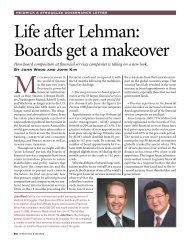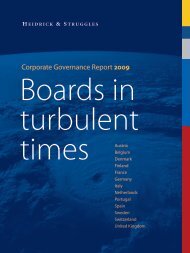A leadership game plan for sports and business - Heidrick & Struggles
A leadership game plan for sports and business - Heidrick & Struggles
A leadership game plan for sports and business - Heidrick & Struggles
You also want an ePaper? Increase the reach of your titles
YUMPU automatically turns print PDFs into web optimized ePapers that Google loves.
een competing against each other ultimately become<br />
teammates <strong>and</strong> colleagues as a result of the confluence<br />
of their character <strong>and</strong> the <strong>leadership</strong> of coaches. A team<br />
‘personality’ or culture is established. The same dynamic<br />
occurs in the corporate world, where highly competitive<br />
executives must be welded into a cohesive team by skillful<br />
leaders.<br />
Once training camp begins, the team’s pro personnel<br />
department has responsibility <strong>for</strong> monitoring individual,<br />
unit, <strong>and</strong> team productivity through ‘quality control.’<br />
Are the individuals, units, <strong>and</strong> divisions meeting the<br />
organization’s pre-determined <strong>and</strong> attainable per<strong>for</strong>mance<br />
goals? Additionally, the pro personnel department is<br />
grading players around the league, <strong>for</strong>ce ranking them<br />
<strong>for</strong> possible trade value. They are also helping the head<br />
coach develop a <strong>game</strong> <strong>plan</strong> <strong>for</strong> each week by scouting<br />
opponents, <strong>and</strong> they may also grade <strong>game</strong> officials. Each<br />
week during the season, free agents are brought in <strong>for</strong><br />
tryouts, adding to the constant evaluation process.<br />
The department also works with the position coaches <strong>for</strong><br />
the exit interview which every player undergoes at the end<br />
of the season. The interview is a complete review of the<br />
year <strong>for</strong> that player, not unlike per<strong>for</strong>mance reviews in the<br />
corporate world, where strengths, weaknesses, <strong>and</strong> areas<br />
<strong>for</strong> improvement are discussed. The player will be given a<br />
complete off-season regime, which includes conditioning<br />
<strong>and</strong> drills <strong>for</strong> improving skills, much as executives are given<br />
development <strong>plan</strong>s.<br />
During the two-month off-season, coaches are available<br />
as well as support staff <strong>for</strong> help <strong>and</strong> guidance. Players<br />
have counselors <strong>for</strong> special issues <strong>and</strong> to the extent<br />
possible are monitored <strong>and</strong> checked with weekly. And, of<br />
course, during the off-season, the coaching staff is doing<br />
a complete needs assessment, fine tuning the operating<br />
strategy <strong>and</strong> preparing to repeat the cycle. As in <strong>business</strong>,<br />
the evaluation process has no off-season.<br />
Leadership issues <strong>and</strong> roles<br />
High-per<strong>for</strong>mance teams often appear to be totally<br />
cohesive externally but in fact are conflicted internally.<br />
Team dynamics are constantly managed by focusing on<br />
the productivity of the player, the unit, <strong>and</strong> the team.<br />
The head coach sets the vision <strong>and</strong> the assistant coaches<br />
are the managers responsible <strong>for</strong> the per<strong>for</strong>mance of the<br />
individual, the units <strong>and</strong> the team.<br />
Like a CEO the head coach deals with fiscal assets,<br />
marketing, financial issues, productivity, innovations,<br />
social responsibility, profitability (as measured by the<br />
competitiveness of the team), but spends most of his<br />
time on human asset objectives, strategy, <strong>and</strong> tactics. His<br />
assistant coaches, as many as 24, are the managers he<br />
must lead, along with the players. While all head coaches<br />
have their own styles, the successful ones all have the<br />
characteristics of the classic effective leader.<br />
Players are expected to develop <strong>and</strong> show continued<br />
improvement both on <strong>and</strong> off the field. Players who fail<br />
typically do so at the beginning or within three years. After<br />
three years, the organization’s confidence in the player<br />
grows <strong>and</strong> he is deemed ascending, mature, or descending<br />
in various areas. Judging each player’s status determines<br />
off-season strategies about re-signing players, signing free<br />
agents, drafting <strong>for</strong> need, succession at various positions,<br />
<strong>and</strong> <strong>leadership</strong>.<br />
The head coach appoints player captains, who are usually<br />
highly respected in the locker room. They may lead in<br />
productivity or by position, but above all they believe<br />
in the head coach, his system, <strong>and</strong> his vision. They trust<br />
the head coach <strong>and</strong> their reputations enable them to<br />
influence the other players. They are good listeners, acting<br />
as counselors to players, <strong>and</strong> bring issues, large <strong>and</strong> small,<br />
to the attention of the head coach.<br />
Coaches – <strong>and</strong> CEOs – must be especially adept at<br />
h<strong>and</strong>ling stars, who can be problematic people <strong>and</strong> create<br />
internal issues. As the saying goes, “anyone can h<strong>and</strong>le<br />
jackasses; it’s hard to h<strong>and</strong>le thoroughbreds.” Most players<br />
recognize that blue chip players – the real <strong>game</strong> changers<br />
– make everyone better. They may not be especially liked<br />
but they are appreciated <strong>for</strong> what they do. Teams believe<br />
that the more quality players, the better chance the team<br />
has to per<strong>for</strong>m well against the best competition. So do<br />
companies, <strong>and</strong> those that succeed have learned not only<br />
how to evaluate, attract, <strong>and</strong> keep top talent, but also how<br />
to integrate that talent with the team <strong>and</strong> the objectives of<br />
the organization.<br />
<strong>Heidrick</strong> & <strong>Struggles</strong> 9

















